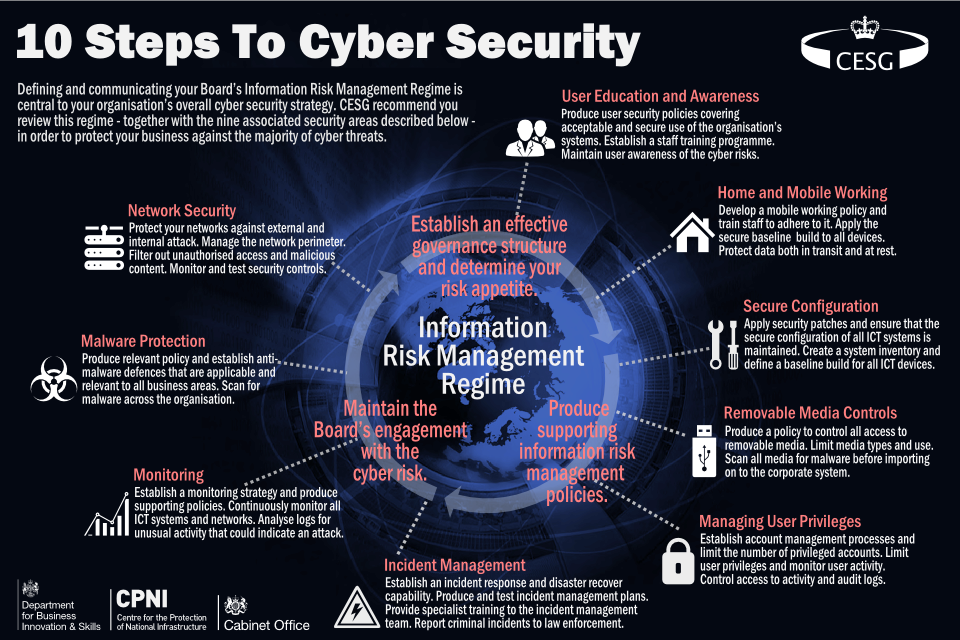Introduction: Why Cybersecurity Matters More Than Ever
In the last decade, cybersecurity threats have shifted from being niche technical problems to becoming critical risks that affect every individual, business, and government system in the United Kingdom. With rapid digital transformation, remote work adoption, and the widespread use of smartphones and smart devices, UK internet users are constantly exposed to cyberattacks ranging from simple phishing scams to sophisticated ransomware operations. For ordinary users, this means that protecting online accounts, financial data, and personal identities has never been more important. For businesses, the stakes are even higher, with reputational damage, regulatory penalties, and operational disruptions often resulting from a single successful attack.
Cybercriminals exploit both technological weaknesses and human vulnerabilities, which makes awareness one of the most effective first lines of defense. By understanding the top cybersecurity threats in the UK, users can better prepare themselves, adopt secure online practices, and minimize risks that could otherwise lead to devastating consequences. This article explores the most pressing cybersecurity dangers UK users face today, explains how they work, provides real-world examples, and outlines strategies for prevention.
The Growing Landscape of Cybersecurity Threats in the UK
The cyber threat landscape in the UK has grown increasingly complex due to global criminal networks, state-sponsored hacking groups, and opportunistic attackers targeting individuals and small businesses. Unlike traditional crime, cybercrime often has a much lower barrier to entry, as malicious software, stolen credentials, and even hacking services can be purchased on underground forums at low cost. This creates an environment where attackers can scale their operations and target thousands of people simultaneously.
Some of the most notable recent trends in the UK include a surge in ransomware incidents affecting hospitals and local councils, phishing campaigns linked to global events such as the COVID-19 pandemic, and the rise of social engineering attacks that exploit human psychology rather than technical flaws. With financial institutions, e-commerce platforms, and government portals being prime targets, UK internet users must remain vigilant not only against well-known risks but also against evolving threats that adapt to new technologies.
To put the changing landscape into perspective, here are three important realities:
- Cybercrime services are now sold “as-a-service” on the dark web, making attacks easier.
- UK public services, especially healthcare, remain prime targets for disruption.
- The use of global events (e.g., tax deadlines, pandemics) as bait is on the rise.
Common Cybersecurity Threats Targeting UK Users
To better understand the risks, it is useful to break down the most common cybersecurity threats UK users encounter daily. While new attack methods emerge regularly, most cybercrimes fall into recognizable categories.
- Phishing attacks remain the most widespread, using fraudulent emails or texts to trick users into revealing passwords or banking details.
- Ransomware has become one of the most financially damaging threats, locking users out of critical files until a ransom is paid.
- Data breaches expose personal and financial information that can later be sold on the dark web.
- Identity theft often follows breaches, leaving victims with fraudulent loans, credit damage, and legal issues.
- Business email compromise (BEC) attacks specifically target UK companies by impersonating executives or vendors.
By recognizing these threats, UK users can take practical steps to reduce their likelihood of falling victim to attacks.
Phishing Attacks: The Persistent Cyber Threat
One of the most common cybersecurity threats in the UK is phishing, a tactic where attackers impersonate legitimate organizations to deceive users into sharing sensitive information. Criminals typically send emails or text messages that mimic banks, delivery companies, or government services, urging users to click on links or download attachments. Once clicked, these links often lead to fraudulent websites designed to capture login credentials, credit card details, or personal data.
The sophistication of phishing campaigns has grown considerably, with some attackers using logos, branding, and even HTTPS certificates to make fake websites appear authentic. For UK users, the rise of smishing (SMS phishing) is particularly concerning, as text messages claiming to be from HMRC, Royal Mail, or NHS are regularly used to manipulate people into quick action. Protecting against phishing requires a combination of skepticism, technical defenses such as spam filters, and continuous awareness of new scam techniques.
Key tips to reduce phishing risks include:
- Always verify the sender’s email or phone number before responding.
- Hover over links to check their true destination before clicking.
- Report suspicious emails or texts to your provider or the NCSC.
Ransomware: A Growing Crisis for UK Users
Ransomware represents one of the most severe cybersecurity challenges in the UK today. This type of malware encrypts files or entire systems, demanding payment (often in cryptocurrency) for decryption keys. Attackers usually target businesses, schools, and hospitals, but individuals can also be victims. The UK’s National Cyber Security Centre (NCSC) has repeatedly warned about ransomware gangs exploiting weak passwords, outdated software, and remote desktop connections.
One of the most infamous ransomware incidents in the UK was the 2017 WannaCry attack, which disrupted NHS hospitals and caused widespread chaos. Since then, ransomware has become more targeted and destructive, with attackers sometimes threatening to leak stolen data if victims refuse to pay. UK users must prioritize data backups, software patching, and endpoint protection tools to minimize risks. Equally important is avoiding the temptation to pay ransoms, as doing so only encourages further attacks.
To safeguard against ransomware, users should:
- Maintain multiple backups, with at least one kept offline.
- Avoid opening suspicious attachments, especially from unknown senders.
- Regularly update operating systems and security software.
Identity Theft and Data Breaches in the UK
The rise of data breaches has exposed millions of UK citizens’ personal details to cybercriminals. Hackers frequently target retail companies, financial services, and online platforms, stealing databases filled with usernames, passwords, and credit card details. Once stolen, this information often appears on dark web marketplaces, where it can be purchased cheaply and used for identity theft.
Identity theft has severe consequences for victims. Fraudsters can open credit accounts, apply for loans, or even commit crimes under stolen identities. Victims often spend years trying to clear their names and repair credit scores. UK users must understand that using weak or reused passwords increases the risk significantly. Employing multi-factor authentication (MFA) and regularly monitoring bank accounts are essential steps toward reducing exposure.
UK users should also remember:
- Data from breaches may circulate for years, long after the initial hack.
- Criminals often combine stolen data from multiple sources.
- Using a password manager reduces the danger of reused credentials.
Social Engineering and Human Exploitation
While many people assume cybersecurity threats rely on technical expertise, a large proportion of attacks succeed because of human error. Social engineering exploits human psychology—curiosity, fear, or urgency—to manipulate users into making mistakes. For example, an employee might receive a convincing phone call from someone claiming to be from IT support, urging them to share their login credentials. Similarly, fraudsters often impersonate delivery drivers or customer service representatives to extract information.
Social engineering thrives on trust and lack of skepticism. For UK businesses, the risk is magnified because staff members may unknowingly provide attackers with access to sensitive systems. Awareness training, verification procedures, and a culture of caution are vital defenses against this subtle yet highly effective form of cybercrime.
To counter social engineering, individuals should:
- Verify requests for information through official channels.
- Question any sense of urgency in messages or calls.
- Limit personal details shared on social media.
Emerging Threats: AI-Driven Cybercrime
The role of artificial intelligence (AI) in cybercrime is expanding rapidly. Cybercriminals are beginning to use AI-powered tools to generate convincing phishing emails, deepfake videos, and automated attacks that adapt in real time. For UK users, this represents a dangerous new frontier, as traditional detection methods may struggle against sophisticated AI-driven scams.
For example, AI voice-cloning technology has already been used in fraud cases where criminals impersonated executives to authorize fraudulent wire transfers. Similarly, deepfake videos may soon play a role in disinformation campaigns. To counter these threats, UK cybersecurity agencies and companies are investing in AI-powered defense systems that can detect anomalies faster than humans. Still, awareness and critical thinking remain essential tools for individuals navigating this new threat landscape.
UK users can prepare for AI-driven threats by:
- Staying informed about new AI fraud techniques.
- Using trusted channels to verify communications.
- Supporting AI-powered security solutions where available.
Cybersecurity Risks in Remote Work and Hybrid Environments
The shift toward remote and hybrid working models across the UK has expanded the attack surface for cybercriminals. Employees working from home often rely on personal devices, insecure Wi-Fi networks, and unsupervised communication tools, making them prime targets for attackers. In many cases, businesses underestimated the long-term impact of remote work and failed to implement strong cybersecurity policies outside the office.
Common risks include unsecured remote desktop connections, weak VPN configurations, and a reliance on outdated hardware. Additionally, collaboration platforms such as Zoom, Teams, and Slack have become frequent attack vectors through phishing links and malicious file sharing. UK companies must establish strict policies for secure remote access, provide updated training, and ensure regular patching of systems to close vulnerabilities.
Remote workers should prioritize:
- Using company-approved VPNs and secure Wi-Fi setups.
- Avoiding personal devices for sensitive work tasks.
- Keeping collaboration software updated with patches.
The Role of Government and Regulation in Cybersecurity
The UK government plays a crucial role in strengthening national cybersecurity defenses. Agencies such as the National Cyber Security Centre (NCSC) provide guidance, tools, and incident response services to both businesses and individuals. Regulatory frameworks like the UK GDPR and Data Protection Act also compel organizations to safeguard customer data and report breaches promptly.
In addition, initiatives like Cyber Essentials certification encourage small and medium-sized enterprises (SMEs) to adopt basic security measures. However, the growing complexity of cyber threats requires continuous adaptation of laws, international cooperation, and stronger enforcement mechanisms. For individual users, government resources can serve as valuable references for improving personal cybersecurity hygiene.
Government-backed initiatives for UK users include:
- Cyber Essentials certification for SMEs.
- Free resources from the NCSC website.
- Legal protections under the Data Protection Act and UK GDPR.
Conclusion: Staying Ahead of Cybersecurity Threats in the UK
As the digital economy grows, so too does the scale and sophistication of cybersecurity threats targeting UK users. From phishing scams and ransomware to AI-driven fraud and social engineering, cybercriminals constantly adapt to exploit new technologies and human vulnerabilities. While government initiatives and corporate defenses play an important role, personal awareness remains the most effective shield.
By adopting strong password practices, enabling multi-factor authentication, staying vigilant against suspicious messages, and keeping software updated, UK users can significantly reduce their exposure to cybercrime. Businesses, meanwhile, must embrace a culture of cybersecurity resilience that prioritizes employee training, data protection, and regulatory compliance. In an age where digital risks are inseparable from daily life, proactive defense is not optional—it is essential for protecting identities, finances, and trust in the online world.
Frequently Asked Questions (FAQs)
1. What are the biggest cybersecurity threats in the UK right now?
The most common threats include phishing attacks, ransomware infections, identity theft, data breaches, and social engineering scams. These affect individuals, businesses, and even government systems on a regular basis.
2. How can I tell if an email is a phishing attempt?
Check for spelling mistakes, suspicious links, unusual sender addresses, and urgent messages demanding immediate action. Hover over links before clicking and avoid downloading unexpected attachments.
3. Are UK banks safe from cyberattacks?
Banks invest heavily in cybersecurity protections, but threats like fraud, credential theft, and phishing remain common. Customers must also use two-factor authentication (2FA) and avoid sharing sensitive details.
4. What is ransomware and how does it spread?
Ransomware is malware that locks or encrypts files until a ransom is paid. It spreads through infected email attachments, malicious downloads, and compromised websites.
5. Do small businesses in the UK face cybersecurity risks?
Yes. Small businesses are often targeted by hackers because they usually have weaker defenses. Threats include data theft, fraudulent invoices, and malware attacks.
6. How can individuals protect their personal data online?
Use strong passwords, enable multi-factor authentication, install security updates regularly, and avoid oversharing personal details on social media.
7. Is public Wi-Fi safe to use in the UK?
Public Wi-Fi is often insecure. Hackers can intercept data on open networks. Use a VPN (Virtual Private Network) to encrypt traffic when browsing on public hotspots.
8. What role does the UK government play in cybersecurity?
The UK has the National Cyber Security Centre (NCSC), which issues guidance, monitors threats, and supports both businesses and individuals in handling cyber incidents.
9. How do social engineering attacks trick UK users?
Cybercriminals exploit psychological manipulation by pretending to be trusted individuals (bank staff, employers, government officials) to steal personal or financial details.
10. What should I do if I’m a victim of a cyberattack?
Immediately change passwords, contact your bank, report the incident to Action Fraud (the UK’s cybercrime reporting centre), and run a full antivirus scan on affected devices.


